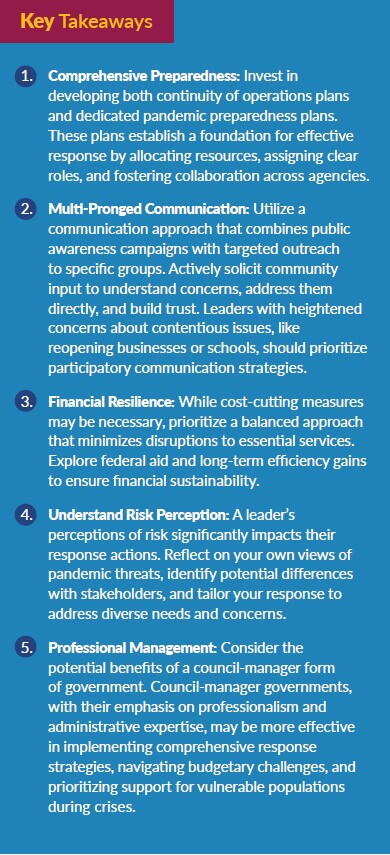
The Pandemic Management Survey
The COVID-19 pandemic underscored the importance of local governments during a crisis response. Municipal leaders were on the frontlines, enforcing health rules, ramping up public health and social services, helping vulnerable communities, and keeping residents informed on public health guidelines.
Responding to this unprecedented global crisis wasn’t easy. Municipal managers faced many challenges, including lack of expertise and resources, conflicting public health information and federal directives, tight budgets, and partisan divide and public skepticism that often hindered a community’s compliance with public health guidelines.
To that end, we conducted the Pandemic Management Survey (PMS),123 examining pandemic response by local governments specifically in the states of Pennsylvania and Florida. The survey, distributed among municipal managers and chief appointed officials of the two states, focused on the following themes:
- Preparedness of jurisdictions for natural and manmade/technological disasters and disease outbreaks.
- Risk perception of local government managers regarding the impact of COVID-19 on their jurisdiction’s public health, local economy, social services, and budget.
- Sources of information for public health–related issues and communication strategies adopted in response to the pandemic.
- Socioeconomic and public health response actions adopted in response to COVID-19.
- Actions taken to reduce the adverse economic impact of COVID-19 on the community and the jurisdiction’s budget.
During the spring of 2021, we distributed the survey via email to 913 local governments with populations greater than 5,000. After data cleaning and coding, the final sample consisted of 102 municipal governments.
Local Response Policies
A central aspect of the survey focused on understanding strategies adopted by local governments in response to the pandemic. We divided response actions into three categories: socioeconomic and public health, communication and community engagement, and budgetary response actions.
Socioeconomic and Public Health Response Actions
We found that municipal leaders acted as community stewards by implementing measures to keep their residents safe and extending additional support to those who were vulnerable. Nearly one in five governments offered financial assistance to households facing economic hardships and evictions. More than a third provided masks, sanitizers, and other medical supplies to communities. Approximately 14% specifically expanded services to the homeless and elderly, recognizing their increased vulnerability. A significant portion (32%) of respondents also developed community response and reopening plans since the start of the pandemic.
Communication and Community Engagement Strategies
The most frequently adopted actions were public awareness campaigns (77%) to keep the community consistently informed on public health guidelines, communicating with local businesses (47%) and ensuring their engagement in response, and receiving community input (45%) to understand their concerns and needs. Other strategies like holding community stakeholder meetings (25%) to foster collaboration and trust with key community groups and facilitating participation of youth (8%) were also adopted.
The data suggests that a multi-pronged approach in crisis communication was adopted during the pandemic. Leaders combined public awareness campaigns with targeted communication to specific groups like businesses and vulnerable residents. They also actively incorporated community input to address specific concerns and build public trust.
Budgetary Response Measures
Seventy percent of responding jurisdictions implemented some form of expenditure cuts that included postponing capital projects, furloughs and staff layoffs, hiring freeze, and reduction of benefits. Almost two-thirds (63%) implemented some revenue raising strategies that included seeking federal aid and borrowing from other jurisdictions. Finally, 12% sought productivity gains by reducing hours of operation, reorganizing and consolidating various departments, and closing some departments.
In summary, the pandemic forced local governments to innovate in managing their finances. The data suggests that while cost cutting was necessary, managers were also required to balance these reductions with increased social service demands from residents. They sought federal aid and focused on long-term efficiency gains by streamlining government operations.
Preparedness Matters
We asked a series of questions designed to assess preparedness capabilities of responding jurisdictions for public health crises events. While three-fourths (75%) of responding jurisdictions had a continuity of operations plan in place, fewer (37%) reported already having a pandemic plan at the start of COVID-19 outbreak.
Why is preparedness important? Having an emergency management plan in place can position jurisdictions for a more effective crisis response by:
Developing a stronger foundation: A plan helps develop the necessary resources like staff, funding, and administrative capabilities to handle a crisis.
Assigning clear roles: The plan assigns clear responsibilities to different stakeholders involved in the response, ensuring everyone knows their part.
Promoting seamless teamwork: The plan establishes collaborative networks and communication channels among various agencies, enabling smooth cooperation during a crisis.
Analysis of our data showed that jurisdictions with an independent continuity of operations plan were 11.5 times more likely to adopt public health and socio-economic response actions such as distribution of medical supplies, expanding services for unhoused residents and the elderly, developing plans for reopening businesses and other community services, and providing financial assistance to those unemployed or facing evictions. Alternatively, jurisdictions with an independent pandemic preparedness plan were 32.5 times more likely to adopt similar response actions.
These findings highlight the urgency to invest in planning for continuity of operations and pandemic management. While local communities can initiate developing these plans, advocating for broader support may also be necessary. These include:
Federal/state funding: Lobbying for increased financial resources from federal and state governments.
Grant opportunities: Exploring and pursuing grant programs that support the development and implementation of local preparedness plans.
Mandates as a catalyst: Advocating for clear mandates from federal or state governments that encourage or require all localities to develop preparedness plans. This can help ensure broader adoption across communities.
Risk Perception Drives Action
The emergency management literature demonstrates that while objective assessment of a threat is necessary, a leader’s subjective perception of the same also matters in crisis decision-making. Leaders with higher risk perception are more likely to have a clearer understanding of the severity of a threat. Their heightened awareness can translate into a stronger sense of urgency to adopt necessary organizational/community protective action measures. We therefore asked respondents of our survey to indicate major concerns related to the pandemic for their jurisdiction. The top three reported concerns were spread of infection (90%), reopening of businesses (81%), and reopening of schools (74%). Some other frequently reported concerns were availability of healthcare resources, unemployment, public safety, and budgetary issues.
Our analysis indicates that how leaders perceived pandemic risk mattered in their choice of pandemic response actions. For example, leaders with higher levels of concerns about reopening businesses and schools, both politically charged topics across various communities in the United States, adopted more community and stakeholder engagement strategies in their response. It is possible that managers with higher levels of concern with divisive issues felt the urgency to implement more avenues for communicating with and engaging with residents so as to lessen the tension surrounding some of these sensitive policies and build public trust and support.
Alternatively, our analysis also indicates that during a crisis, specific concerns of public managers can also influence how leaders approach budget challenges. We observed the

following:
- Leaders concerned about hospital capacity and public safety were more likely to seek additional funding sources like federal aid or borrowing.
- Leaders worried about healthcare resources and school reopening were less likely to implement expenditure cuts.
- Leaders concerned over budget constraints and human services adopted both expenditure cuts and productivity gains in government operation.
Our analysis indicates the following actionable items for leaders:
Self-assessment: When a crisis hits, take time to reflect on your own risk perception regarding potential threats from the situation.
Community dialogue: Engage with stakeholders to understand their concerns about potential impacts.
Flexible response plans: Adapt your response in a way that can address both objective assessment of threats and ease specific concerns of community members and stakeholders.
The City/County Manager Effect
While local communities were instrumental in leading the crisis response, we were interested to examine how those communities with the council-manager (C-M) form of government compared to other local government structures in adoption of pandemic response strategies. The debate on performance comparisons between the C-M form and other forms of government is not new. Scholars and practitioners have argued that jurisdictions with an appointed chief administrative officer (CAO) benefit from increased professionalism and administrative expertise of managers. Consequently, communities with the C-M form are advocated to be more efficient, responsive, and effective in government operations.
Our analysis reveals that the form of government mattered. Jurisdictions with the C-M form of government led to adoption of more socioeconomic and public health strategies and impacted budgetary decisions. C-M communities in our sample seemed to prefer productivity gains in operation over cost-cutting measures to navigate budget shortfalls. In essence, C-M local governments can lead a more effective pandemic response because of the following factors:
Reduced political influence: C-M local governments, unlike those led by elected officials, are less susceptible to political agendas. This allows for evidence-based decision making, prioritizing tough public health and socioeconomic programs, even when politically unpopular.
Collaborative approach: C-M local governments, guided by professional ethics, can be better at navigating conflicting needs and fostering collaboration. City/county managers can build trust and engage diverse community stakeholders, leading to a more comprehensive pandemic response.
Innovation and adaptability: During needed budget adjustments, managers, leveraging their professional expertise, have the capability to go beyond cost-cutting measures and explore other techniques such as cost control and productivity enhancement.
Conclusion
The findings from our survey provide insight into local response during COVID-19 and reveal various actionable steps that municipal governments can take to address future public health crises. The sidebar on this page contains a summary of key takeaways.
VASWATI CHATTERJEE is an assistant professor in the department of public administration at Villanova University, USA.
THEODORE ARAPIS is an associate professor and chair of public administration at Villanova University, USA.
Endnotes
1 Chatterjee, V., & Arapis, T. (2024). Crisis communication during COVID-19: Insights from Pennsylvania and Florida local governments. Risk, Hazards & Crisis in Public Policy.
2 Arapis, T., & Chatterjee, V. (2024). Analysing cutback management strategies amidst the Covid 19 pandemic: Insights from Pennsylvania municipalities. Public Money & Management, 1-12.
3 Chatterjee, V., & Arapis, T. (2023). Examining COVID-19 response among local governments through the political market framework. Journal of Emergency Management, 21(7), 111-131.
New, Reduced Membership Dues
A new, reduced dues rate is available for CAOs/ACAOs, along with additional discounts for those in smaller communities, has been implemented. Learn more and be sure to join or renew today!
